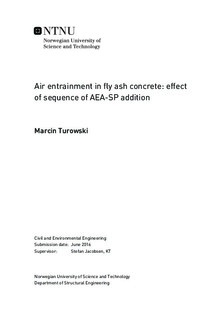| dc.description.abstract | Frost resistance of concrete is directly dependent on its air content and parameters of air void system. Nowadays concrete is rarely produced without water-reducing agents, used also in air-entrained mixes. Sequence of adding admixtures during mixing seem to affect final properties of concrete, concerning its performance throughout service life.
This work is a result of studying the effect of different adding sequences of air-entraining agents (AEA) and superplasticizer (SP) on air content in mortar. The basis for work is a study of foam index change for different materials and adding sequences, carried out by a group of BSc students in spring 2015 [1].
Consequently, a set of experiments for materials of interest (2 different AEAs, 1 co-polymer SP, 1 OPC, 1 Norwegian fly ash and 1 limestone filler), used in the above mentioned study, were performed.
The following parameters of the mix were selected: OPC/FA 70/30, mass of limestone 5% of binder, w/c ratio 0,45. Matrix volume was changed during the experiment from 330 to 400 litres. Whole range of received data is included in the report for a broader overview of the effect of AEA and SP mixing sequence.
The results shows that, notwithstanding matrix volume and type of AEA used, sequence of adding admixtures has a significant influence on the air content in concrete both in fresh and hardened state.
It is noted that when SP is added after AEA, the effect of AEA is reduced while in mixes where AEA is added after SP, the air content is higher, presumably due to adsorption of SP. The highest air content gives adding AEA together with SP. The appreciable difference in the air content is also noted for different AEAs, coming from different producers. An attempt for characterizing of air-void parameters for most interesting cases was abandoned due to insufficient strength for polishing of young fly ash mortar, unveiled at last stage of the procedure. | |

